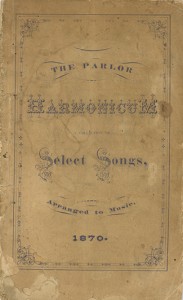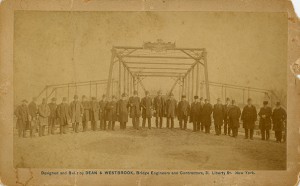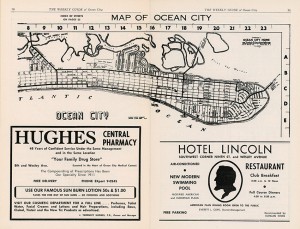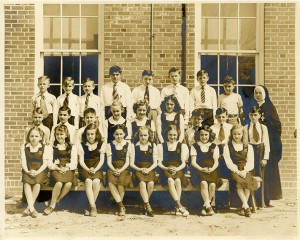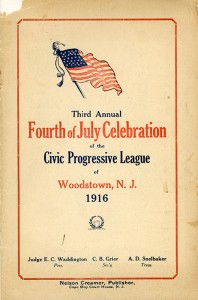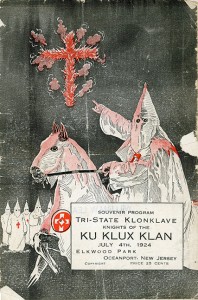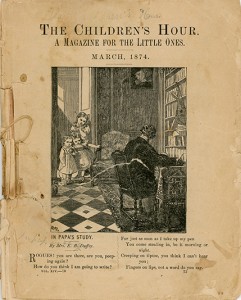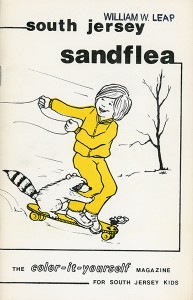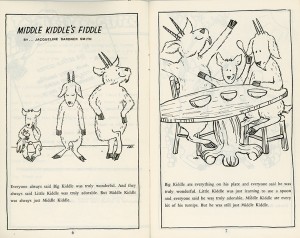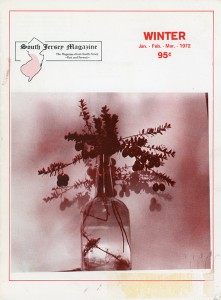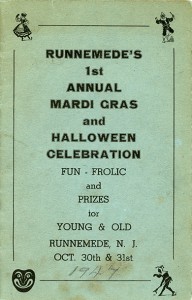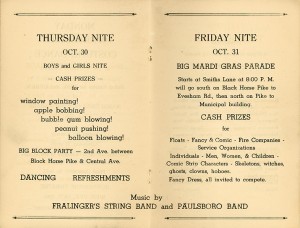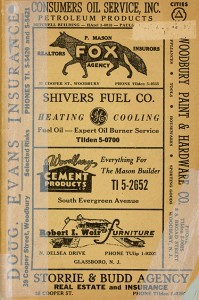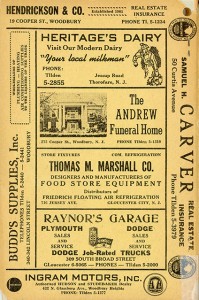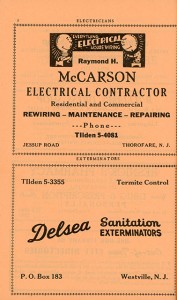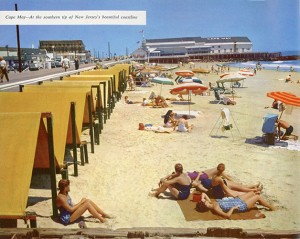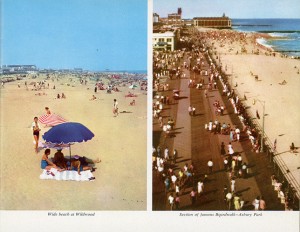Bridging the Gap
Things that we had, things that we lost; things that will hardly be remembered and almost surely be forgotten—this is ephemera, the unintentional foot-prints left by time to be washed away with the incoming tide—unless we save them, to remind us of the toil and strife of a daily life made beautiful by a song, by a hard day’s work, or by the pride of a job well done.
Ephemera are not the sort of items that will be preserved in museums as the apex of human achievement during the age of their creation. No, the things you will find in this case are things that are more likely to end up in the trash, things that were useful for only a short period of time. To us, though, they are a remnant of the past, a snapshot of daily life, a glimpse into real people’s ideals, values, and desires—and how time has changed those perspectives. Like the old Mauricetown Bridge, people must change and adapt to the current status quo. They are often stubborn and unwilling, sticking their feet in the mud and crossing their arms, but sooner or later they will have no choice. The train of progress rumbles by, stopping for no one. In its path it leaves who we were—the songs we sang, the bridges we built, the people we knew. If we’re not careful to grab some of it when we get the chance, history will be just that—long-lost memories replaced by important dates and names that neglect real life; the way people lived, loved and worked day in and day out, thinking not of being remembered in the future, but of simply making the most of every day.
*
The Parlor Harmonicum: A Collection of Select Songs, Arranged to Music. n.p. 1870.
MoTown and Music
The selection of ephemera in this case—selected from a large cache of such material in Special Collections—ranges in date from 1870 to 1976. A quick glance at the items on either side of this blurb is all one needs to recognize that they are certainly not from our time.
The Harmonicum is a collection of tunes from the 19th century—these songs are heard no more. In the span of a human life, an individual song is no more than a flash, a few minutes of joy relegated to a place deep in the mind where fond memories reside. Music, however fleeting it may be, provides people with tangible expressions of sorrow, desire, and love. The songs in this collection are romantic odes, hard-luck blues, and upbeat good-time tunes. These particular songs may be obsolete, but the meaning and feeling of the music is timeless.
Around the same time those songs were being sung, the Mauricetown bridge was being built. Maybe those same tunes were playing on repeat in the workers’ minds, helping to push them through another day of hard labor. Completed in 1888, all that now remains is the entrance to the bridge, turned into a scenic picnic area. If the men who constructed this bridge were to return, they would see that their work had been replaced with a much more modern, much larger span that allows boats to freely pass beneath it, a major issue with the old bridge. When it was decided that this relic of the past could not properly function in the present, crews recognized that the deep, thick mud surrounding the bridge would make their job incredibly difficult. This made the construction process much longer than originally anticipated. As a local news-paper writer commented, the oldest bridge in the area would be remembered as “the bridge of the last laugh.” The bridge, like this old picture and the men in it, will someday be forgotten, but it made sure to give people another reason to remember it, if only for a little while. The bridge’s swan song could easily be taken from the Harmonicum tune “All the Old Folks are Gone”:
Here I wander sad and lonely,
In the dear old home, those that I loved so
Well and fondly, all, all the old folks are gone.
The bridge and the music (the “old folk” of South Jersey) are gone, but for now, they are not forgotten.
*
Ocean City has grown dramatically since this map was put into the Weekly Guide of Ocean City, NJ in August of 1959 (ask anyone familiar with the area about the bridge construction), but the motives of the town have stayed the same. Ocean City is and will continue to be a dry town dedicated solely to family fun. The town is famous nationwide as a great place for families to vacation, which makes it interesting to look at a bland, black and white map of the town. The names of the main streets remain the same: Simpson, Haven, West, Asbury, Central, and Wesley. This image reminds us that as much as time changes culture, some aspects endure.
*
History Repeats Itself
If you have attended any sort of school, public or private, odds are you have been part of a class picture. The photograph of students shown here was taken of 4th and 5th graders in 1947 in the town of Mt. Ephraim. This picture, which provides no identification for the students, nevertheless, tells us a great amount about their social norms. The photograph is bland—it is black and white—the students are wearing uniforms and none show more than a smirk. This differs tremendously from the way we take class pictures today (barring, perhaps, some private schools). The approach to picture making has evolved, but the class picture itself has remained as a fixture of school life.
*
Third Annual Fourth of July Celebration of the Civic Progressive League at Woodstown, N.J. Woodstown, NJ, 1916.
American Celebrations
For more than two centuries in America, the Fourth of July has been known for festive celebrations and extravaganzas, with ceremonies, parades, games and fireworks. For generations people have gathered in parks and fields to share a fun-filled day, enjoying whatever events came their way on the grand occasion. On display from Special Collections are two quite different Fourth of July programs held by two New Jersey towns.
This program describes the third annual Woods-town Fourth of July celebration. The events of the day included games, concerts, and a parade at which the councilmen greeted the audience with a warm welcome. In this thirty-five-page program, the people of Woodstown, as well as others from outside the borough, were offered information about the town’s officials, its history, and its major landmarks, such as schools, churches, and amusements. The program also provides numerous advertisements. On almost every page, one can see that ice cream companies, lumber companies, automobile makers, banks, and farmers tried to bring attention to their businesses through their support of this event.
Tri-State Klonklave Knights of the Ku Klux Klan. Oceanport, NJ, 1924.
A second program describes the Ku Klux Klan’s Independence Day spectacular in Oceanport in 1924. Surprisingly, and chillingly, the Klan held normal Fourth of July celebrations, similar to those in most communities that allowed people to come together and enjoy the day. This small program provided a schedule for the events of the day, which began at eight in the morning and lasted until midnight. The Klan welcomed their guests with band concerts, an address, and an opening prayer by State speakers. Games, like races and baseball games, were played throughout the day. There were also religious events, such as a Klan wedding and christening. At nighttime, the Knights of the KKK and the women of the KKK began their ceremonials. Afterward, a firework show lit up the sky, concluding the night with songs entitled “The Fiery Cross” and “America.”
*
The Children’s Hour. A Magazine For the Little Ones. March 1874.
Sandflea and Children’s Hour
Here we have two pieces from two completely different time periods. Over 100 years apart in age, these two titles for tots contain plenty of interesting stories and tidbits for any reader’s enjoyment. Want to read stories about mischievous little children and animals with good old-fashioned artwork? Well, take a look at Children’s Hour, a brief little magazine chock full of them. It contains riveting tales, such as “Delicate Nellie,” “Tommy’s Temptation,” and “The White Mice.” What makes this little booklet even more of a must-read is that it contains its own interpretation of the Pompeii disaster, in the form of the tale called “A Dead and Buried City.” With all of these tales and the occasional handwritten notes here and there, this tiny anthology serves as a window into a world once seen through the eyes of a child living in 1874 South Jersey.
If that isn’t an intriguing enough piece of literature for the common folk looking for good light reading, then perhaps the South Jersey Sandflea will pique the interest. This magazine, published in 1976 in Runnemede, is a great example of what South Jersey kids in the 70s found entertaining. It, too, is filled with tales and trivia that could make any child’s imagination race, all of which are written for, about, and by children. It contains pieces such as “Middle Kiddle’s Fiddle” where a goat named Middle Kiddle proves how “wonderful” he is to his brothers by playing the fiddle. There is even one section ded-icated to stories sent in by avid readers. Also, for anyone interested in delving into the hopes and dreams of a child, take a gander at the “One of Our Own” section and read about the life ambitions of little John Wuertz.
Both pieces make a great addition to the Stockton Special Collections, and they are a must read for those wanting to take a peek at a piece of history.
South Jersey Sandflea: The Color-It-Yourself Magazine for South Jersey Kids. Runnemede, NJ: Jacqueline Bardner Smith, 1976.
*
South Jersey Magazine 1.1. Winter 1972.
The editor’s note from the first ever issue of the South Jersey Magazine in 1972 included a line that could serve well as a motto for the region: “We can’t please everyone, but we are going to try.” South Jersey has done this by building casinos, making the beaches more attractive, and promoting the area to tourists as a seashore-and-pine tree alternative to New York and Philadelphia. The magazine highlights South Jersey culture of the past and present, providing informative essays about the people and places that make this slice of earth unique and presenting engaging tales of years past. The page following an exposition of modern cran-berry harvesting practices tells the story of a Dr. John Mordridge, a Bridgeton man from the late 1800s. Mordridge would travel from farm to farm, selling medicine from his horse-drawn wagon. To alert neighbors of his arrival, the doctor would sing out:
Here I come to let you know
Old Doc Mordridge is still on the go.
Was afraid to pass you by,
For fear you might get sick and die.
He would conclude his song with a list of the drugs he was peddling, which often included hot bitters, elixirs, and cough syrup. The magazine also provided useful information for its contemporary readers, including a classified section, where a reader could post a search query in an effort to enhance his Boy Scout patch collection, or sell a fifty year-old tennis set (which is still in great condition!). Today, there are at least two competing “South Jersey Magazines,” though it is unclear that either is successor to the publication before you.
*
Runnemede’s 1st Annual Mardi Gras and Halloween Celebration. Runnemede, NJ: 1947.
The Halloween Jamboree
Known for its amusement and merrymaking, Halloween has brought people together for generations. The customs have certainly changed through the years, ever since it originated from All Hallows’ Eve. Celebrations differ in various parts of the world. Many celebrate with the classic trick-or-treating, where children disguised in their humorous or creepy costumes run about town in search of sweets and treats. Others hold a variety of town events, such as contests, parades, and dances. The leaflet shown displays Runnemede’s first annual Mardi Gras and Halloween celebration, held in 1947. The celebration welcomed young and old. In the pamphlet, a schedule of the three-day event was given, beginning with a costume dance at St. Teresa’s Church, the local parish. At the block party held the night before Halloween, boys and girls would compete in bubble gum blowing, peanut pushing, and window painting contests for cash prizes. To conclude the event, a Mardi Gras parade marched down the Black Horse Pike to the municipal building. Cash prizes were given to the best floats and best costumes for men, women, and children. Throughout the program, compliments to the different townspeople were made and advertisements for the various businesses around town were displayed.
*
Woodbury Classified Directory
This directory is full of intriguing items. Besides being an early form of what would later become the yellow pages, it is also filled with advertisements of places and things that no longer exist in our modern age. The cover provides a good example of what to expect throughout this strange little reference tool. With its ads for the “P. Mason Fox Agency” and “Woodbury Cement Products” sprawled on the front cover, it seems obvious that the publishers of this book were concerned about commerce. This concern ran deep, as the advertisements make up at least three-fourths of this novel-sized directory.
The other quarter of the book is, as the name suggests, a telephone directory. This, too, is historically provocative, since unlike the modern 10-digit phone numbers with which we are familiar, the numbers provided are 5 digits long. Even the advertisements follow this form, suggesting that 5-digit phone numbers were typical in that day and age.
*
“Vacation Guide to New Jersey.” New Jersey State Promotion Section. Trenton, New Jersey. N.d.
Whether you say, “going to the shore” or “going to the beach,” one thing is certain; South Jersey is known for its beaches. The Vacation Guide to New Jersey makes this clear through its beautiful, although outdated, pictures. The images show how our beaches have evolved, for better or for worse, over time. The swimwear is definitely more conservative in these pictures, which depending on your views could be a good or bad thing. The boardwalks today have more clutter, including restaurants, shops, and even surreys, that occupy the wooden walkway. In the past, it looks as though it was exactly what the name entails—boards to walk on. Lastly, the beaches themselves look much larger in yesteryear than they do today. Storms, tides, and erosion have left today’s beaches with much less sand and much more ocean. Regardless of whether our beaches continue to diminish, their place in South Jersey history is safe.
